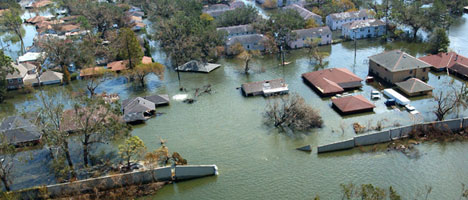Flooding and Extreme Precipitation

Contacts, for more information:
 Tom Delworth |
 Tom Knutson |
 Gabe Vecchi |
 Chris Milly (USGS) |
Related Areas of Research:
Possible increases in riverine or stream flood risk and in extreme precipitation are two major concerns about future climate warming. These concerns arise from both projected increases in average precipitation minus evaporation in a number of regions, and from projected increases in precipitation extremes. Increases in extreme precipitation, which are expected as a consequence of increased atmospheric water vapor in a warmer climate, have been detected and attributed to anthropogenic forcing in at least one study to date. Sea level rise associated with future climate warming is expected to contribute toward increasing the risk of extreme coastal flooding events, although the full change in risk will depend also on other factors such as changes in the coastal storm climate and infrastructure.
GFDL Research
GFDL scientists are working toward a better scientific understanding of these possible impacts of climate change. With the land model LM3, GFDL climate models now have the potential to better represent runoff responses to climate change, not only through influence of snow-water equivalent and soil moisture conditions, but also of water-table depth, streamflow and lake levels. The lab is also active in research related to sea level rise.
Tropical cyclones are an example of a phenomenon that can produce extreme precipitation events, and GFDL scientists are using dynamical downscaling techniques to investigate the relationship between climate warming and tropical cyclone precipitation.
Featured Results
- Resolution dependence of contiguous US precipitation extremes in response to CO2 forcing
- An extreme event of sea-level rise along the northeast coast of North America in 2009-2010
- Seasonal- and annual-mean precipitation extremes occurring during 2013: A U.S. focused analysis
- Runoff in a changing climate: “Stationarity is Dead”
- Model projections of the changes in atmospheric circulation and surface climate over North America, North Atlantic and Europe in the 21st century
- Dynamical downscaling projections of late 21st century Atlantic hurricane activity: CMIP3 and CMIP5 model-based scenarios
- Controls of global snow under a changed climate
- The GFDL CM3 model
Publications
- Knutson, T. R., J. J. Sirutis, M. Zhao, R. E. Tuleya, M. A. Bender, G. A. Vecchi, G. Villarini, and D. Chavas (2015): Global Projections of Intense Tropical Cyclone Activity for the Late Twenty-First Century from Dynamical Downscaling of CMIP5/RCP4.5 Scenarios. Journal of Climate, 28(18), DOI:10.1175/JCLI-D-15-0129.1.
- Paul B. Goddard, Jianjun Yin, Stephen M. Griffies and Shaoqing Zhang (2015): An extreme event of sea-level rise along the Northeast coast of North America in 2009?2010. Nature Communications. DOI: 10.1038/ncomms7346.
- Villarini, G., R. Goska, J. A. Smith, and G. A. Vecchi, 2014: North Atlantic Tropical Cyclones and U.S. Flooding. Bull. Amer. Meteor. Soc., 95, 1381-1388. doi: 10.1175/BAMS-D-13-00060.1
- Knutson, T. R., F. Zeng, and A. T. Wittenberg, 2014: Seasonal and annual mean precipitation extremes occurring during 2013: A U.S. focused analysis. Section 6 of: “Explaining extreme events of 2013 from a climate perspective.” Bull. Amer. Meteor. Soc., 95 (9), S19-S23. doi: 10.1175/ExplainingExtremeEvents2013.1.
- Knutson, T. R., J. J. Sirutis, G.A. Vecchi, S. Garner, M. Zhao, H.-S. Kim, M. Bender, R. E. Tuleya, I. M. Held, and G. Villarini (2013): Dynamical Downscaling Projections of Late 21st Century Atlantic Hurricane Activity: CMIP3 and CMIP5 Model-based Scenarios. J. Climate. DOI: 10.1175/JCLI-D-12-00539.1
- Lau, N.-C., J. J. Ploshay. (2013) Model Projections of the Changes in Atmospheric Circulation and Surface Climate over North America, North Atlantic and Europe in the 21st Century. J. Climate. DOI: 10.1175/JCLI-D-13-00151.1
- Kapnick, S. and T. Delworth. (2013) Controls of Global Snow Under a Changed Climate. J Climate. DOI: 10.1175/JCLI-D-12-00528.1
- Villarini, G., J.A. Smith and G.A. Vecchi (2013): Changing Frequency of Heavy Rainfall Over the Central United States. J. Climate, DOI:10.1175/JCLI-D-12-00043.1.
- Lintner, B R., M Biasutti, N S Diffenbaugh, J E Lee, M J Niznik, and Kirsten L Findell, (2012): Amplification of wet and dry month occurrence over tropical land regions in response to global warming. J. Geophys. Res., 117, D11106, DOI:10.1029/2012JD017499.
- Villarini, G, J.A. Smith, M.L. Baeck, T. Marchok, and G.A. Vecchi (2011): Characterization of Rainfall Distribution and Flooding Associated with U.S. Landfalling Tropical Cyclones: Analyses of Hurricanes Frances, Ivan and Jeanne (2004). J. Geophys. Res. DOI:10.1029/2011JD016175
- Milly, P C., et al., (2010): Terrestrial water-storage contributions to sea-level rise and variability In Understanding Sea-Level Rise and Variability, Oxford, UK, Wiley-Blackwell, 226-255.
- Findell, K. L., and T. L Delworth (2010): Impact of common sea surface temperature anomalies on global drought and pluvial frequency. J. Climate, 23(3), DOI:10.1175/2009JCLI3153.1.
- Lettenmaier, D, and P C D Milly (2009): Land waters and sea level. Nature Geoscience, 2, DOI:10.1038/ngeo567.
- Milly, P C., J Betancourt, M Falkenmark, R M Hirsch, Z W Kundzewicz, D Lettenmaier, and R J Stouffer (2008): Stationarity is dead: Whither water management? Science, 319(5863), DOI:10.1126/science.1151915.


